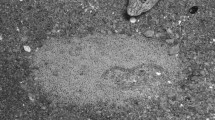Abstract
The mate choice and mating pattern of a benthic goby Rhinogobius sp. CB (cross band type) were investigated in the Kamo River, Shikoku, Japan. During the breeding season, gravid females assumed a nuptial color and either males or females initiated a courtship display. Males preferentially courted a female of similar size to lead her to his nest, whereas females courted more frequently when they encountered a large male. Eggs in any one nest were always at the same developmental stage. Sampling data of nesting males and females indicated that, in more than half the nests, males gathered more than one female before spawning. In some nests with eggs, two or three females had spent ovaries, indicating that the eggs were laid by multiple females within a short span of time. However, a comparison between the total number of eggs which females would spawn in one nest and the number of eggs actually deposited suggested that eggs were contributed by one female in most nests. This low level of polygyny in spite of multiple female availability is attributed to a limited available spawning area of the nest.
Similar content being viewed by others
References cited
Berglund, A., G. Rosenqvist & I. Svensson. 1989. Reproductive success of females limited by males in two pipefish species. Am. Nat. 133: 506-516.
Bisazza, A. & A. Marconato. 1988. Female mate choice, male-male competition and parental care in the river bullhead, Cottus gobio L. (Pisces, Cottidae). Anim. Behav. 36: 1352-1360.
Breder, C.M. Jr. & D.E. Rosen. 1966. Modes of Reproduction in Fishes. Natural History Press, Garden City, New York. 527 pp.
Clutton-Brock, T.H. & A.C.J. Vincent. 1991. Sexual selection and the potential reproductive rates of males and females. Nature 35: 58-60.
Côte, I.M. & W. Hunte. 1989. Male and female mate choice in the redlip blenny: Why bigger is better. Anim. Behav. 38: 78-88.
Dôtu, Y. 1959. The life history and binomics of the Gobiid fish, Aboma lactipes. Bull. Fac. Fish. Nagasaki Univ. 8: 196-201.
Dôtu, Y. 1961. The binomics and life history of the Gobioid fish, Rhinogobius giurinus. Bull. Fac. Fish. Nagasaki Univ. 10: 120-125.
Dôtu, Y. & S. Mito. 1963. The binomics and life history of the Eleotrid fish, Asterropteryx semipunctatus. Bull. Fac. Fish. Nagasaki Univ. 5: 10-15.
Goto, A. 1993. Male mating success and female mate choice in the river sculpin, Cottus nozawae (Cottidae). Env. Biol. Fish. 37: 347-353.
Gross, M.R. & R.C. Sargent. 1985. The evolution of male and female parental care in fishes. Amer. Zool. 25: 807-822.
Hastings, P.A. 1988. Female choice and male reproductive success in the angel blenny, Coralliozetus angelica (Teleostei: Chaenopsidae). Anim. Behav. 36: 115-124.
Ito, S. 1997. Mate choice in Rhinogobius sp. LD and sp. CB. Unpublished M.Sc. Thesis, Ehime University, Matsuyama. 24 pp.
Ito, S. 2002. Reproductive tactics and mating system in stream gobies of genus Rhinogobius. Doctoral Thesis, Ehime University, Matsuyama. 95 pp.
Ito, S. & Y. Yanagisawa. 2000. Mate choice and cannibalism in a natural population of a stream goby, Rhinogobius sp. Ichthyol. Res. 47: 51-58.
Kawanabe, H. & N. Mizuno. 1989. Freshwater Fishes of Japan. Yamatokeikoku-sha, Tokyo, Japan. 590 pp (in Japanese).
Kuwamura, T. 1985. Social and reproductive behavior of three mouthbrooding cardinalfishes, Apogon doederleini, A. niger and A. notatus. Env. Biol. Fish. 13: 17-24.
Lindström, K. & M. Hellström. 1993. Male size and parental care in the sand goby, Pomatoschistus minutus. Ethol. Ecol. Evol. 5: 97-106.
Lindström, K. & T. Seppä. 1996. The environmental potential for polygyny and sexual selection in the sand goby, Pomatoschistus minutus. Proc. R. Soc. Lond. B 263: 1319-1323.
Magnhagen, C. 1998. Alternative reproductive tactics and courtship in the common goby. J. Fish Biol. 53: 130-137.
Marconato, A. & A. Bisazza. 1988. Mate choice, egg cannibalism and reproductive success in the river bullhead, Cottus gobio L. J. Fish Biol. 33: 905-916.
Marconato, A., A. Bisazza & G. Marin. 1989. Correlates of male reproductive success in Padogobius martensi (Gobiidae). J. Fish Biol. 34: 889-899.
Matsumoto, K. & Y. Yanagisawa. 2001. Monogamy and sex role reversal in the pipefish Corythoichthys haematopterus. Anim. Behav. 61: 163-170.
Miller, P.J. 1984. The tokology of gobiid fishes. pp. 119-153. In: G.W. Potts & R.J. Wootton, (ed.) Fish Reproduction: Strategies and Tactics. Academic Press, London.
Mizuno, N. 1976. Studies on a freshwater fish, Rhinogobius brunneus (Pisces: Gobiidae). Distribution of four colour types in Shikoku and Kyushu Islands. Physiol. Ecol. Japan. 17: 373-381 (in Japanese).
Mizuno, N., S. Uehara & M. Maki. 1979. Studies on a freshwater fish, Rhinogobius brunneus (Gobiidae). Habitat segregation among sympatric populations of 4 color types. Jap. J. Ecol. 29: 137-147 (in Japanese).
Sargent, R.C., M.R. Gross & E.P. van den Berghe. 1986. Male mate choice in fishes. Anim. Behav. 34: 545-550.
Sone, S., M. Inoue & Y. Yanagisawa. 2001. Habitat use and diet of two stream gobies of the genus Rhinogobius in southwestern Shikoku, Japan. Ecol. Res. 16: 205-219.
Takahashi, D. & Y. Yanagisawa. 1999. Breeding ecology of an amphidromous goby of the genus Rhinogobius. Ichthyol. Res. 46: 185-191.
Takahashi, D. 2000. Conventional sex roles in amphidromous Rhinogobius goby in which females exhibit nuptial coloration. Ichthyol. Res. 47: 303-306.
Takahashi, D., M. Kohda & Y. Yanagisawa. 2001. Male-male competition for large nests as a determinant of male mating success in a Japanese stream goby, Rhinogobius sp. DA. Ichthyol. Res. 48: 91-95.
Trivers, R.L. 1972. Parental investment and sexual selection. pp. 139-179. In: B. Campbell (ed.) Sexual Selection and the Descent of Man 1871-1971. Aldine Press, Chicago.
Vincent, A.C., I. Ahnesjö, A. Berglund & G. Rosenqvist. 1992. Pipefishes and seahorses: Are they all sex role reversed? Trends Ecol. Evol. 7: 237-241.
Williams, G.C. 1975. Sex and Evolution. Princeton University Press, Princeton, New Jersey. 200 pp.
Author information
Authors and Affiliations
Rights and permissions
About this article
Cite this article
Ito, S., Yanagisawa, Y. Mate Choice and Mating Pattern in a Stream Goby of the Genus Rhinogobius . Environmental Biology of Fishes 66, 67–73 (2003). https://doi.org/10.1023/A:1023294310871
Issue Date:
DOI: https://doi.org/10.1023/A:1023294310871




